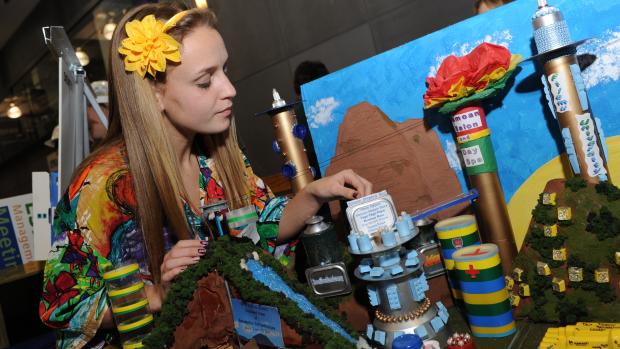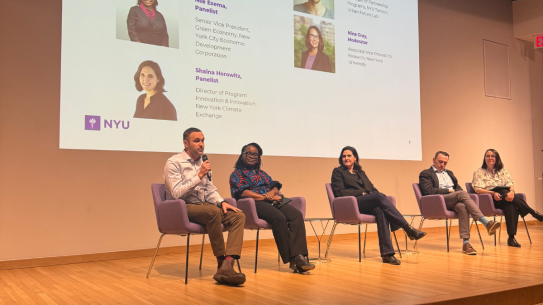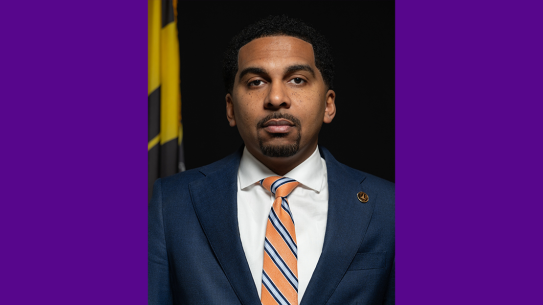Building for Tomorrow: NYU-Poly Hosts Regional Future City Competition

The theme for this year’s Future City competition — devised months ago — couldn’t be more timely: providing an affordable living space for people who have lost their home due to a disaster or financial emergency.
On the morning of Saturday, January 23 at Polytechnic Institute of NYU, just hours after the Hope for Haiti telethon raised $57 million to help rebuild Haitian lives, homes, and cities, seventh- and eighth-grade students from New York City, Long Island, and Westchester County schools presented their Future City designs at the regional finals of the annual competition.
Students created four elements showcasing their best thinking: a computer-generated model of the city they envision; a tabletop model of that city built to scale; a presentation and oral defense of their design; and an essay on the topic. In addition, the 3D version of their city had to be made of recycled materials and could cost no more than $100.
Twenty-three teams representing 15 schools and over 100 student participants, teachers, mentor-engineers, and family members came to cheer on theregional finals teams.
[GALLERY:2988|left]
The top three regional winning teams, Fa’a Filemu (Islip Middle School), Oma’oma’o (IS 24 Myra S. Barnes), and Large Fork (Eugenio Maria DeHostos) earned scholarships to NYU-Poly, and first-place regional winners received a trip to the 18th annual Future City National Finals in Washington, D.C., February 13-17 during National Engineers Week. The national grand prize is a trip to U.S. Space Camp in Huntsville, Alabama
Praise for a job well done
Evaluating students’ designs is never easy. “Every year it gets better,” said Joe Boccuzzi, an NYU-Poly alumnus (2004) who has volunteered as a judge for the contest since 2007. He described the submissions as thought-provoking, high praise from a principal scientist at Broadcom Corp, a cellular telecommunications company. “There’s a lot of hunger and determination in these kids,” Boccuzzi said. “They’re energized. They’re excited.”
That emotion inevitably yields competitive design, according to Rob Fitton, another NYU-Poly alumnus (1993) who has volunteered for Future City. Last year he mentored a team from Jericho Middle School in Long Island and found himself inspired by what he saw. “The technical acumen, how well the presentations were done — it was really great stuff,” Fitton said.
Successful partnerships
His participation supports the efforts of NYU-Poly’s David Packard Center for Technology and Educational Alliances, which has organized the Future City regionals since 1997. The center pairs volunteers from NYU-Poly with area schools to advance science and technology education among students and teachers alike.
Russ Holstein, an instructor at IS 318 who welcomed an NYU-Poly mentor to his classroom this year, said “It’s almost like having another teacher in the room. I’m getting a lot out of it, too, because I’m being re-exposed to certain areas of physical science I had long forgotten.”
He’s not the only one who benefits from the partnership with NYU-Poly; kids do, too. “The adults — teacher or mentor —say similar or identical things, but we come across in much different ways, and the kids hearing it and being able to process it differently each time, it sinks in better,” Holstein said.
The future: powered by innovation
Student development is at the heart of Future City for Dr. Noel Kriftcher, director of the David Packard Center. “Nothing is more important to the future than teaching critical thinking skills, especially as they concern the health of our environment,” he said.
Fitton agreed with him and added another point: Future City maintains the country’s competitiveness in the global marketplace. “The more we have young people thinking about ways we can conserve our environment, how we can approach things like housing — as they get older, they get more and more interested in it, and you keep innovation going in the US,” he said.
Barbara Kates-Garnick, project director of NYU-Poly’s Urban Initiative, added, “Young people are the intellectual future of the city. They’re going to be the people educating this next generation of scholars.”




